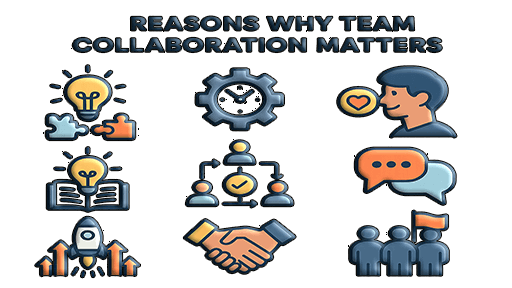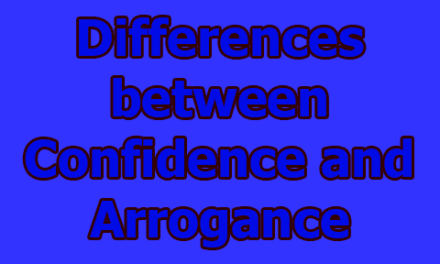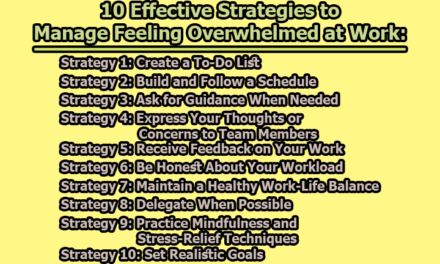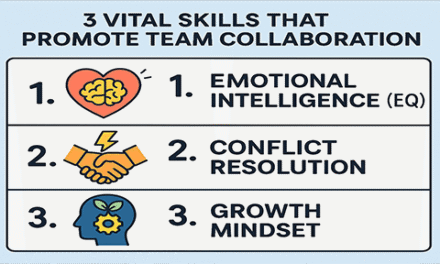Reasons Why Team Collaboration Matters:
In today’s dynamic and complex work environments, team collaboration is more than a buzzword — it is a fundamental driver of organizational success. Whether in small teams or large, cross-functional groups, collaboration harnesses the diverse strengths, experiences, and ideas of individuals to achieve outcomes that often exceed what any one person could accomplish alone. Effective team collaboration has been linked to higher performance, greater innovation, stronger engagement, and healthier workplace cultures. This article explores ten compelling reasons why team collaboration matters.
1. Enhanced Problem-Solving and Creativity: One of the most powerful benefits of team collaboration is its ability to improve problem-solving and spark creativity. Complex challenges in the workplace rarely have simple solutions, and tackling them often requires input from people with diverse skills and viewpoints. When individuals from different departments or backgrounds come together, they bring unique experiences and ways of thinking to the table — this diversity of thought can reveal solutions that might otherwise be overlooked.
For example, an engineering team might be excellent at technical problem-solving but may miss key user experience insights that a marketing or customer support team could provide. By collaborating, they can merge technical expertise with customer perspectives to design better products or services. Research supports this: teams with high levels of collaborative behavior are more likely to generate innovative ideas and successfully implement them (Salas et al., 2015; Hülsheger et al., 2009).
Brainstorming sessions, cross-functional project groups, and idea-sharing platforms are practical ways organizations can harness this benefit. When team members feel encouraged to share even unconventional ideas without fear of judgment, it builds an innovative culture where creative problem-solving thrives.
2. Increased Productivity and Efficiency: While it may seem counterintuitive, working together often saves time rather than wastes it — provided the team collaborates effectively. A large body of research links teamwork directly to higher productivity and operational efficiency (Beal et al., 2003). When employees share tasks and responsibilities, they can divide work according to each person’s strengths and availability, preventing burnout and delays.
For instance, one team member may excel at data analysis, another at visual presentation, and another at communicating findings to stakeholders. By distributing tasks strategically, teams can complete projects faster and with higher quality than if individuals worked alone.
Moreover, effective teamwork fosters shared accountability. Team members who know others rely on their contributions are more motivated to meet deadlines and maintain standards, creating a self-sustaining loop of responsibility and high performance (Mathieu et al., 2008).
Modern project management tools, clear role definitions, and open communication channels are practical supports that help teams achieve this productivity boost.
3. Stronger Employee Engagement and Job Satisfaction: Humans are inherently social beings — we naturally seek connection and belonging. Team collaboration taps into this basic human need by creating a sense of community and shared purpose at work. When people collaborate well, they feel part of something larger than themselves, which strengthens their organizational commitment.
Social identity theory suggests that our self-image is partly shaped by the groups we belong to (Tajfel et al., 1971). In collaborative environments, people identify with their teams, which in turn gives them a sense of pride and behavioral guidance. They are more likely to help each other, share information freely, and trust one another. This trust and sense of belonging boost engagement and morale.
Additionally, workplaces that encourage collaboration tend to have healthier cultures. Research shows that collaborative cultures have higher job satisfaction and lower turnover rates because employees feel more valued and connected (Haslam et al., 2020; Gallup, n.d.).
Practical examples include regular team-building activities, inclusive decision-making, and recognizing team efforts rather than only individual achievements — all of which nurture a positive, engaged work culture.
4. Continuous Learning and Skill Development: One of the most underrated advantages of teamwork is how powerfully it supports continuous learning and skill building. When people work closely with others, they naturally pick up new ideas, methods, and tools they may not have encountered on their own. Collaboration is essentially a built-in learning system — individuals observe how teammates solve problems, use technology, communicate, or manage tasks, and they often adopt these practices themselves.
For example, a junior employee who collaborates with a senior colleague can learn advanced techniques or industry insights simply through day-to-day interaction. Similarly, cross-department projects expose employees to new domains outside their own area of expertise. Over time, these experiences broaden their knowledge base and build transferable skills like negotiation, conflict resolution, and critical thinking (Johnson & Johnson, 2009).
Organizations that encourage collaborative learning also create an environment where people feel comfortable asking questions, offering feedback, and sharing mistakes as learning opportunities. Peer mentoring, job shadowing, project debriefs, and collaborative platforms like wikis or shared knowledge bases are practical ways to foster this continuous development.
5. Better Decision-Making: Team collaboration can lead to better, more thoughtful decisions — especially in complex or high-stakes situations. When people work together, they can critically examine ideas from multiple angles, challenge assumptions, and reduce the risk of “groupthink” — the tendency for everyone to go along with the first solution to maintain harmony, even if it’s flawed.
According to Nemeth (1986), having dissenting opinions within a group can actually improve decision quality by encouraging deeper evaluation of evidence and alternatives. Diverse perspectives make it less likely that blind spots or biases will derail the decision-making process.
This is particularly important today, as organizations strive to meet diversity, equity, and inclusion (DEI) goals. When decision-making includes voices from different backgrounds, it not only improves outcomes but also signals to employees that their input matters — which, in turn, builds trust and engagement.
To make the most of this benefit, leaders should create team norms that encourage constructive debate, respectful disagreement, and open discussion. Tools like structured brainstorming, anonymous idea submission, or rotating meeting facilitators can help ensure all voices are heard.
6. Improved Communication: Effective collaboration depends on — and strengthens — good communication. Working in teams naturally encourages people to exchange information, clarify expectations, and provide updates, which reduces misunderstandings and duplication of work.
When collaboration is strong, communication flows both formally and informally. Formal communication happens through meetings, project updates, and shared documents, while informal communication occurs through casual check-ins and spontaneous discussions. Together, they create a culture of transparency and alignment (Salas et al., 2015).
Good team communication also helps resolve conflicts quickly. When people feel comfortable expressing concerns or misunderstandings, they can address issues before they escalate. Teams that communicate well are better equipped to adapt to sudden changes, reprioritize tasks, and keep everyone on the same page — which is especially crucial for remote or hybrid teams.
Practical strategies for improving communication in collaborative settings include setting clear communication norms, using collaborative tools like Slack or Microsoft Teams, and encouraging regular feedback loops to ensure information is shared openly and effectively.
7. Greater Innovation Capacity: Collaboration is a key driver of innovation. When people feel safe to share fresh ideas and test new approaches without fear of failure or judgment, they’re more willing to experiment and take calculated risks. Diverse teams that openly exchange ideas often spark breakthrough solutions that a single individual or siloed team might overlook (Hülsheger et al., 2009).
For example, many of the world’s most innovative companies — think Google or IDEO — build cross-functional teams that bring together engineers, designers, marketers, and users early in the development process. By blending technical expertise with creative input and customer insights, they accelerate the journey from concept to market-ready innovation.
Research shows that collaborative environments create fertile ground for “creative abrasion” — the healthy friction that occurs when people debate and refine ideas together. Organizations can cultivate this by encouraging brainstorming sessions, hosting innovation challenges, or supporting “innovation labs” where teams can test ideas with minimal risk.
8. Enhanced Trust and Psychological Safety: Trust is the backbone of effective collaboration. When people trust their teammates, they’re more willing to share ideas, admit mistakes, ask for help, and give constructive feedback — all of which strengthen team performance. Collaboration builds this trust over time through open dialogue, shared responsibility, and mutual support (Mathieu et al., 2008).
Psychological safety — the belief that no one will be punished or humiliated for speaking up with ideas, questions, or concerns — is a crucial element here. Research shows that teams with high psychological safety are more innovative and productive because people feel safe to challenge the status quo and contribute honestly (Salas et al., 2015).
Leaders play a big role in creating this environment. They can encourage trust by modeling openness, inviting input from everyone, acknowledging contributions, and ensuring that mistakes are treated as learning opportunities rather than failures. Simple practices like regular team check-ins, peer recognition, and feedback sessions can go a long way toward building a foundation of trust.
9. Resilience and Adaptability: In a rapidly changing business environment, teams that collaborate effectively are better equipped to handle disruptions. When challenges arise — whether it’s a sudden shift in market demand, a new competitor, or an unexpected crisis — collaborative teams can respond quickly by pooling their knowledge and problem-solving together (Beal et al., 2003).
Instead of relying on a single leader to find all the answers, resilient teams tap into the collective intelligence and flexibility of their members. They can adjust roles, reassign tasks, and pivot strategies as needed. For example, during the COVID-19 pandemic, many organizations that already had strong collaborative cultures adapted more successfully to remote work and rapidly changing customer needs.
Building resilience through collaboration requires clear communication channels, trust, and shared accountability so teams can make quick, coordinated adjustments without confusion or delays.
10. Stronger Organizational Culture: Finally, when collaboration is embedded into an organization’s way of working, it helps shape a positive and inclusive culture. A collaborative culture is one where people feel respected, valued, and part of a collective mission — which can attract top talent and boost retention (Haslam et al., 2020; Gallup, n.d.).
Organizations that encourage teamwork over unhealthy competition foster mutual respect and support, breaking down silos that often hinder knowledge sharing. This kind of culture also tends to align well with DEI goals because it creates more opportunities for people from different backgrounds to have a voice in meaningful decisions (Nemeth, 1986).
Leaders can reinforce this by recognizing and rewarding team achievements, promoting cross-team projects, and providing collaborative workspaces — whether physical or virtual — that make working together easy and enjoyable.
A strong collaborative culture becomes self-sustaining: the more people see the value and feel the benefits, the more they invest in building and maintaining it.
In conclusion, collaboration is not just about working together — it is about unlocking the full potential of diverse minds united by a common goal. Organizations that nurture collaborative practices benefit from enhanced creativity, higher productivity, better decision-making, and more engaged employees. In an era defined by rapid change and increasing complexity, prioritizing teamwork and collaboration is no longer optional; it is essential for sustainable success. By fostering environments where people can freely share, learn, and grow together, leaders can build resilient, innovative, and high-performing organizations ready to tackle the challenges of tomorrow.
Frequently Asked Questions (FAQs):
What does “team collaboration” actually mean at work?
Team collaboration is more than just people working on the same task — it’s a deliberate way of working where individuals actively share ideas, listen to each other, divide responsibilities according to strengths, and coordinate their efforts toward a common goal. True collaboration requires trust, clear communication, and a sense of shared responsibility for outcomes. It can happen within one team, between departments, or even with external partners and clients.
Why is team collaboration so important for organizations today?
Organizations face increasingly complex challenges that no single person or department can solve alone. Whether it’s responding to market changes, innovating new products, or serving diverse customers, collaboration brings together people with different skills and viewpoints to find better solutions. Companies that encourage teamwork tend to be more productive, creative, and adaptable — all of which help them stay competitive in fast-changing industries.
How does teamwork boost creativity and innovation?
When people from different backgrounds work together, they bring fresh ideas and unique ways of thinking. This mix of perspectives helps teams think outside the box, challenge old assumptions, and combine ideas in new ways. Many breakthrough products and services come from teams that welcome open discussion and respectful debate. Organizations that value this kind of teamwork create environments where people feel safe to share ideas that might not be fully formed yet — and that’s often where innovation starts.
How does teamwork affect employee engagement and retention?
Humans naturally crave connection and a sense of belonging. Working in a supportive team helps people feel part of something meaningful. When employees know their contributions matter to the team’s success, they tend to be more motivated, committed, and satisfied with their jobs. Workplaces that encourage collaboration often have stronger cultures and lower staff turnover because people feel valued, trusted, and connected to their colleagues.
Can collaboration ever hurt productivity?
Yes — collaboration needs to be managed well to be effective. If teams spend too much time in unnecessary meetings or don’t have clear goals, collaboration can waste time instead of saving it. The key is balance: good teamwork allows people to share ideas and coordinate work, but also gives them enough time for focused individual tasks. Clear roles, efficient meetings, and strong communication help teams avoid “collaboration overload.”
What can leaders do to make collaboration more effective?
Leaders play a crucial role in creating a collaborative environment. They set the example by encouraging open dialogue, listening to all voices, and recognizing team success. They can break down barriers between departments, provide the right tools and spaces for teamwork, and handle conflicts fairly. Great leaders also welcome healthy disagreements within the team — this often leads to better decisions and stops everyone from just agreeing for the sake of it.
What tools help teams collaborate better?
There’s no shortage of tools designed to make teamwork easier. Project management platforms help teams organize tasks and deadlines. Messaging apps and video calls keep everyone connected, especially in remote or hybrid work settings. Shared document tools allow people to work on the same files at the same time, cutting down on endless email chains. The best tools are the ones that fit your team’s work style and help keep everyone aligned.
How does teamwork help people learn and grow?
Working with others is one of the best ways to learn on the job. By collaborating, people naturally pick up new skills and knowledge from their teammates. They see different problem-solving styles, learn new technologies, and get feedback on their own ideas. Collaboration also helps people develop valuable skills like communication, negotiation, and leadership — which benefit their careers long-term.
How does collaboration connect to diversity and inclusion?
A collaborative team creates space for different voices to be heard. When people with diverse backgrounds and perspectives work together, they’re more likely to spot blind spots and challenge biases. This leads to better decisions that reflect a wider range of experiences. To support diversity through teamwork, it’s important to make sure everyone feels safe to share their ideas and opinions — and that those contributions are respected.
What are some common challenges to effective collaboration?
Even with the best intentions, teams can run into obstacles. Common challenges include poor communication, unclear roles, lack of trust, or teams working in silos without sharing information. Remote teams may struggle with time zones or less face-to-face interaction. Overcoming these challenges requires clear communication, a culture of trust, good tools for sharing information, and leaders who encourage teamwork and handle conflicts quickly and fairly.
References:
- Beal, D. J., Cohen, R. R., Burke, M. J., & McLendon, C. L. (2003). Cohesion and performance in groups: A meta-analytic clarification of construct relations. Journal of Applied Psychology, 88(6), 989–1004. https://doi.org/10.1037/0021-9010.88.6.989
- (n.d.). Employee engagement & experience. Retrieved April 21, 2025, from: https://www.gallup.com/workplace/229424/employee-engagement.aspx
- Haslam, S. A., Haslam, C., Jetten, J., Cruwys, T., & Dingle, G. A. (2020). Social identity. In K. Sweeney, M.L. Robbins & L.M. Cohen (Eds.), The Wiley encyclopedia of health psychology (pp. 679–688). John Wiley & Sons Ltd.
- Hülsheger, U. R., Anderson, N., & Salgado, J. F. (2009). Team-level predictors of innovation at work: A comprehensive meta-analysis spanning three decades of research. Journal of Applied Psychology, 94(5), 1128–1145. https://doi.org/10.1037/a0015978
- Johnson, D. W., & Johnson, R. T. (2009). An educational psychology success story: Social interdependence theory and cooperative learning. Educational Researcher, 38(5), 365–379. https://doi.org/10.3102/0013189X09339057
- Mathieu, J., Maynard, M. T., Rapp, T., & Gilson, L. (2008). Team effectiveness 1997-2007: A review of recent advancements and a glimpse into the future. Journal of Management, 34(3), 410–476. https://doi.org/10.1177/0149206308316061
- Nemeth, C. J. (1986). Differential contributions of majority and minority influence. Psychological Review, 93(1), 23–32. https://doi.org/10.1037/0033-295X.93.1.23
- Salas, E., Shuffler, M. L., Thayer, A. L., Bedwell, W. L., & Lazzara, E. H. (2015). Understanding and improving teamwork in organizations: A scientifically based practical guide. Human Resource Management, 54(4), 599–622. https://doi.org/10.1002/hrm.21628
- Tajfel, H., Billig, M. G., Bundy, R. P., & Flament, C. (1971). Social categorization and intergroup behaviour. European Journal of Social Psychology, 1(2), 149–178. https://doi.org/10.1002/ejsp.2420010202

Library Lecturer at Nurul Amin Degree College










